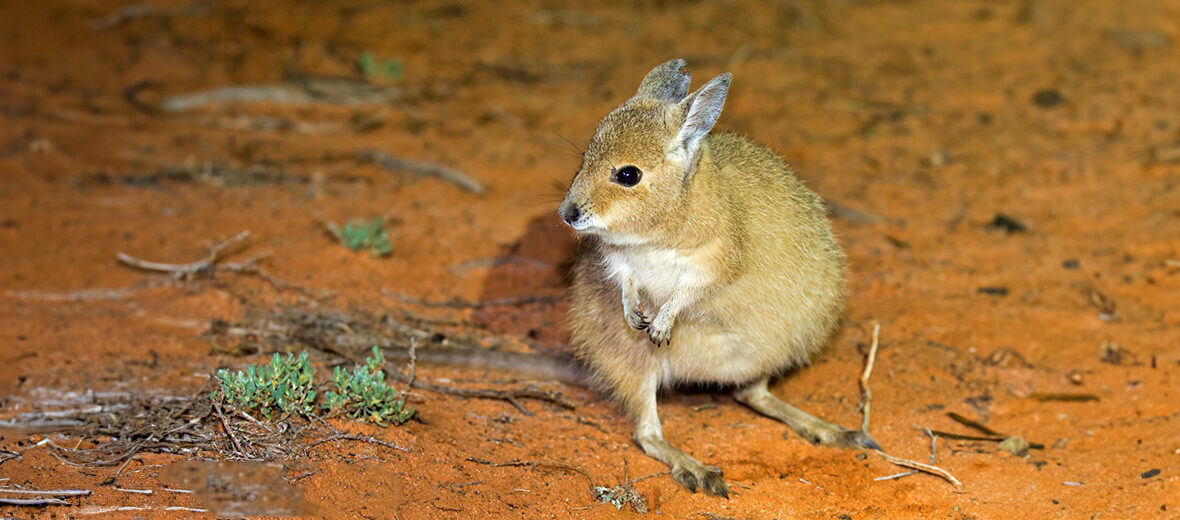
The rufous hare-wallaby, aka mala, once roamed throughout western Australia but now only resides on Bernier Island and Dorre Island off the coast of western Australia, with more populations to come. These macropods (marsupials) face the threats of habitat destruction at the hands of fires and fire suppression; and invasive species, and with them predation. They are listed as Vulnerable by the IUCN. Their population trend is currently listed as stable. There were approximately 4,000 wild individuals as of 2012.
First the Stats…
Scientific name: Lagorchestes hirsutus
Weight: Up to 3.53 lbs.
Length: Up to 11.81 inches, plus up to a 10.63 inch tail
Lifespan: Up to 13 years
Now on to the Facts!
1.) The once prominent populations on mainland Australia were driven to extinction in the early 1990s due to predation by feral cats, foxes, and wildfires.
2.) For a while, the only specimens that existed were in captivity.
3.) These critters prefer spinifex sandplain habitat. Spinifex is hummock grass (forested ground rising above a marsh) endemic to Australia.
4.) They build burrows using spinifex as the roof. During the hotter summer months, they dig even deeper burrows to escape the incredible temperatures.
5.) In 2019, the first reintroductions into the Newhaven Sanctuary were carried out, releasing 30 individuals into a 36+ square mile predator-free habitat.
But wait, there’s more on the rufous hare-wallaby!
6.) Recently, hare-wallaby populations from both Bernier Island and Dorre Island were translocated to Dirk Hartog Island following the total removal of livestock and feral cats from the area.
7.) John Gould, a European, first described the rufous hare-wallaby in 1844 in The Mammals of Australia literature.
Did you know…?
Currently, there are captive bred stocks being introduced to the Tanami Desert in the Northern Territory.
8.) There are 3 known subspecies existing today: Lagorchestes hirsutus bernieri, Lagorchestes hirsutus dorreae, and Lagorchestes hirsutus ssp. There were 4 subspecies, but Lagorchestes hirsutus hirsutus sadly went extinct in the early 1990s before conservation efforts could save them.
9.) For the Anangu, aka Aboriginal people, the Mala or “hare wallaby people” are cherished ancestral beings. For over 10,000 years, the Mala have watched over them from caves, rocks, and walls, guiding them on their journeys with people, animals, plants, & general rules for living and caring for their country.
10.) Rufous hare-wallabies are solitary and only come together to mate.
But wait, there’s still more on the rufous hare-wallaby!
11.) Upon meeting, a male will sexually inspect a female. If she not responsive, she will run away or even kick. However, if responsive to mating, the female will lay in the prone position and accept the male’s advances.
12.) As is the case with other macropods, rufous hare-wallabies will often display embryonic diapause (a temporary suspension of an embryo’s development that happens when the embryo is in the blastocyst stage).
Did you know…?
The name Lagorchestes translates to “dancing hare.”
13.) Embryonic diapause allows the female to decrease the time between litters if conditions are favorable and food is abundant, put an embryo on hold, or even abort the embryo, in the event of a drought.
14.) The short gestation (pregnancy) and brief pouch-life of 124 days allows these critters to birth up to 3 litters a year. Weaning is completed in up to 5 months.
15.) They are both quadripedal (move on all 4 legs) and bipedal (move on 2 hind legs).
But wait, there’s still a tad more on the rufous hare-wallaby!
16.) These critters are nocturnal (active at night).
17.) Seeds, fruits, leaves, stems, forbs, perennial grasses, grass seed heads, sedge bulbs, dicotyledonous plants (a flowering plant with an embryo that bears 2 cotyledons – seed leaves), spinifex, and small insects make up their diet.
Now a Short Rufous Hare-Wallaby Video!
Be sure to share & comment below! Also, check out the Critter Science YouTube channel. Videos added regularly!
Want to suggest a critter for me to write about? Let me know here.
Some source material acquired from: Wikipedia & IUCN
Photo credit: Michael Hains – iNaturalist



